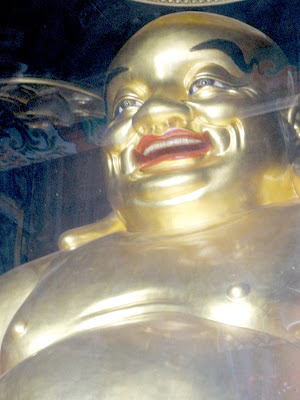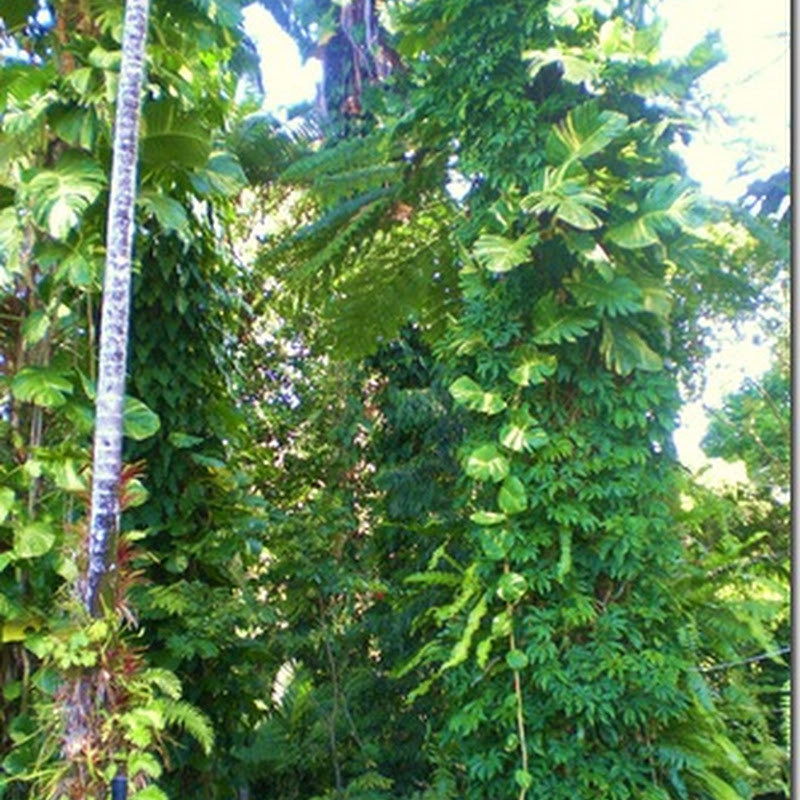Ms.Loh’s place is not for everyone but for the last couple of years it became my base in Southeast Asia. When I first arrived in Malaysia with Ayşegül, we learned that we had to wait for two months for her passport extension and started looking for a home. It was clear from the beginning that, one, we couldn’t spend so much time in a guesthouse room, and two, we couldn’t stay in a big town like Georgetown no matter how much we may like it for a short time. So we ended up looking for a house for rent on the far side of Penang Island, in a fisherman village named Teluk Bahang. And we were fortunate enough to have read the few lines on a friend’s guidebook, saying that in Teluk Bahang, there is this place with such an endearing garden that some people end up staying a long long time. It turned out to be true.
The garden is on one of the backstreets of Teluk Bahang, away from the packed fisherman village, surrounded by a durian plantation. Because of these giant trees (it takes a big tree to carry such big fruits) there are no neighbors around. And in this garden, on one side of the road are some 4 buildings spread out among all kinds of fruit and flower trees, coconuts, durian, starfruit, rambutan, mango, hibiscus and others. All buildings are made of wood and even from a short distance they are lost among the vegetation. The main house is just a ground floor one with a long veranda in the front. It has 10 rooms for guests, one main room which also houses the protector deity of the house and a big kitchen. Then there is a side bungalow with 3 rooms, and two separate buildings which have some rooms on the upper floor while one of them has a nice big shaded area looking the garden under it. The place is big and there is much open space.
 Home Day (winter solstice) morning Ms.Loh appeared early in the morning to
Home Day (winter solstice) morning Ms.Loh appeared early in the morning tolight up this huge incense and give lots of pink offerings to the protector of the house.
As soon as I saw the kitchen I knew I’d choose to stay there and I’d love it. The kitchen has a great diversity of equipment that concentrated there over many years. Some bowls and utensils almost look antique but it also has two working refrigerators and a working stove which makes all the difference. Anyone who has lived in a community knows how important the kitchen is for the social interaction there. And it’s the same here. You meet everyone around the kitchen. And the tap water is drinkable, what a great rare luxury. And you can do your yoga or whatever practice in the shade, or play your guitar on one of the garden swings all around the place (Ms.Loh loves garden swifts so we have many).
Ms.Loh is a Chinese lady in her 70’s. She’s been running this guesthouse for over 35 years. To have space and freedom for the guests she has moved from inside the village into this garden 25 years ago. At that time there were many travelers on this side of the world. Those were the good days of 20th century, before islamophobia stopped travelers from visiting so-called Muslim countries (as if countries have religions). So the tourism development stopped and small places shut down. But Ms.Loh survived thanks to all the people who saw this place as their home and kept coming. The place has this potential to make one dream of old time travelers places because it’s one of the few remaining relics of that age. You can actually find travel guides and magazines from 70s and 80s and it’s not hard to loose time.
Apart from the trees and flowers, the garden is a home to a lot of animals. First, we have the dogs, the numbers of which is usually between 5 and 10 but can get over that if two bitches give birth at the same time. Then we have the rats and mice, which are the nighttime visitors. They seem to enjoy having big football games up on the roof every night but luckily not for a very long time. The first month here it was one of my favorite evening pastimes to sit and watch them carefully but with short rapid moves approach the dogs’ food bowls, grab a chunk of leftover rice and make their run behind a rock or up a tree. They are responsible for the cleanup. Then we have some lizards, the millions of geckos which make these birdlike sounds and eat mosquitoes (which is why we like them I think) and the occasional monitor lizard. Monitors are huge lizards. First time I saw one I was really scared because I thought it was a crocodile. The big ones you can see around here are perhaps 1,5 – 2 meters but they can get bigger than that. Raja, one of Ms.Loh’s handymen, tries to convince us that it’s the monitors that take the puppies when they get lost and not the Muslims (Muslims here don’t like dogs and sometimes kill them). There is a family of these monitors living under the bridge just on the border of the garden but they are very shy and they’re also very scared of the dogs. Raja also says they caught some really big snakes in the garden just on the other side of the road but I only met one green tree snake in the bathroom once (which turned out to be a quite poisonous one). Philip swears he saw a black cobra in the toilet once. Macaque monkeys make their ways all the way from the nearby national park to the durian orchard on the other side of the road but luckily they don’t cross the road and enter our territory. Then there are birds. Mynas are also big fans of dog food and they also come to clean the dinner table. Then there are small colorful flowerpeckers which hover in the air and suck nectar from flowers with their long curved beaks. A little after noontime comes the golden orioles and sometimes you can see a fish eagle nesting on one of the highest trees. Wire-tailed drongos make their number 8 dances almost look like they want to catch that black butterfly following their tails. And there are butterflies, many big colorful butterflies.
Then there are the inhabitants of Ms.Loh’s place. Since this is not the kind of place that pops up as a guesthouse in the minds of people who carry guidebooks, the fast travelers usually leave a bit disappointed. Most places these days offer rooms with attached toilets or even air conditioners, and of course, newer beds. But some see the garden, get hooked up on cooking and end up staying longer than they intended. The main crew of the place however are people who make it their base when they travel and mostly for many many years. There are people who keep coming back here for tens of years and of course they are old. Because of this mostly it is a good place to hear some old travelers’ tales and get some good advice. But of course some old people complain a lot and are not flexible anymore, and some people cannot handle old travelers. So there is this social dance that takes place in this garden and without taking parts or feeling included in any group, I like doing this dance. I like communities anyway. Some would say this is not a community because we pay for things, have our rooms and things and we don’t have any prior agreement with each other. But I like to see it as a small experimental society. A unique one.



























































